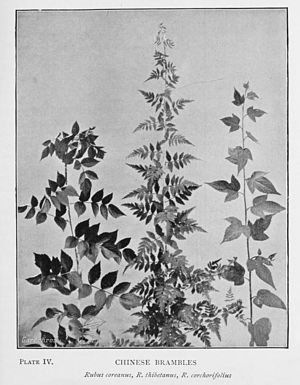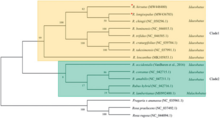| Rubus coreanus | |
|---|---|

| |
| Scientific classification | |
| Kingdom: | Plantae |
| Clade: | Tracheophytes |
| Clade: | Angiosperms |
| Clade: | Eudicots |
| Clade: | Rosids |
| Order: | Rosales |
| Family: | Rosaceae |
| Genus: | Rubus |
| Species: | R. coreanus |
| Binomial name | |
| Rubus coreanus Miq. 1867 | |
| Synonyms | |
| |

Rubus coreanus, known as bokbunja (Korean: 복분자), Korean blackberry, or Korean bramble, is a species of raspberry native to Korea, Japan, and China. It produces edible berries (not 'true berries' in the botanical sense) that can be fermented into bokbunja ju (Korean: 복분자주), a Korean fruit wine (although the majority of fruit commercially grown for producing this drink are actually Rubus occidentalis, native to North America). R. coreanus fruits are usually harvested between the May and July at peak harvest season. They can only be cultivated in a few areas in Korea, different to Rubus occidentalis, which can be cultivated widely across the country.
Species variations
Rubus coreanus belongs to an extensive family of various fruit species with similar qualities. The genus Rubus (family Rosacea) comprises 600 to 800 species distributed in temperate climate and polar regions of the world. Fruits of Rubus species, commonly known as raspberries in Europe and the United States of America are largely distinguished by their color (red, black, and purple). Approximately 20 Rubus species are naturally found in Korea, including Rubus parvifolius, Rubus crataegifolius, Rubus corchorifolius, Rubus oldhamii, and Rubus coreanus.
Folk medicine use and health claims
Rubus coreanus has been used as traditional alternative medicine, as well as regular food, depending on its ripeness. Various studies are claimed to have demonstrated that fruits of R. coreanus might reduce the risk of diseases, including asthma, allergies, and obesity (unripe fruits) and might be effective in reducing inflammation. They are said to exhibit antioxidative, antipyretic, anticancer, and anti-high cholesterol properties, similar to many other fruits and vegetables.
Advertised compounds and industrial methods of making plant extracts
R. coreanus is rich in antioxidant compounds. A major active compound in R. coreanus, like in every other raspberry and several other fruits and nuts, is ellagic acid, which in the marketing of Korean raspberry products is especially claimed to possess anti-obesity and antioxidant properties.
Ellagic acid has been marketed as a dietary supplement with various claimed benefits against cancer, heart disease, and other diseases. In the 21st century, numerous U.S.-based supplement companies received FDA warning letters for promoting ellagic acid with false anti-disease claims that violate the Federal Food, Drug, and Cosmetic Act. Ellagic acid has been identified by the FDA as a "fake cancer 'cure'". There is no scientific evidence to support the claims that ellagic acid can treat or prevent cancer.

Fruit and leave extracts from R. coreanus for products capitalizing on health claims are made by several methods; the most employed being conventional reflux heating or sonication extraction. Both methods share the same pre-preparation stage for samples before extraction. All samples are washed, dried in shade, and ground to a fine powder using a mill. In the reflux method, the ground powder is extracted using a Soxhlet extractor for three hours, with the extracts being filtered and concentrated using a rotary evaporator under a vacuum. In the ultrasonic bath extraction method, samples are extracted with 70% methanol using an ultrasonic bath at 64 °C for 2 h.
See also
References
- "The Plant List: A Working List of All Plant Species".
- photo from Watson, William, Climbing plants Publisher: London : T.C. & E.C. Jack Language
- ^ English Names for Korean Native Plants (PDF). Pocheon: Korea National Arboretum. 2015. p. 336. ISBN 978-89-97450-98-5. Archived from the original (PDF) on 25 May 2017. Retrieved 22 December 2016 – via Korea Forest Service.
- BSBI List 2007 (xls). Botanical Society of Britain and Ireland. Archived from the original (xls) on 26 June 2015. Retrieved 17 October 2014.
- "Rubus coreanus Miquel". Flora of China.
- Eu, Gee-Suck; Chung, Byung-Yeoup; Bandopadhyay, Rajib; Yoo, Nam-Hee; Choi, Dong-Geun; Yun, Song-Joong (2008). "Phylogenic Relationships of Rubus Species Revealed by Randomly Amplified Polymorphic DNA Markers" (PDF). Journal of Crop Science and Biotechnology. 11 (1): 39–44.
- Lee, Jungmin; Dossett, Michael; Finn, Chad E. (2014). "Mistaken Identity: Clarification of Rubus coreanus Miquel (Bokbunja)". Molecules. 19 (7): 10524–10533. doi:10.3390/molecules190710524. PMC 6271795. PMID 25045891.
- Lee, Jungmin; Dossett, Michael; Finn, Chad E. (2013). "Anthocyanin fingerprinting of true bokbunja (Rubus coreanus Miq.)". Journal of Functional Foods. 5 (4): 1985–1990. doi:10.1016/j.jff.2013.06.006.
- Lee, Jungmin (2015). "Analysis of bokbunja products show they contain Rubus occidentalis L. fruit". Journal of Functional Foods. 12: 144–149. doi:10.1016/j.jff.2014.11.005.
- ^ Lee, M. J., Nam, J. H., Jeong, J. H., Rho, R. I., (2020). Effect of Plant Part, Extraction Method, and Harvest Time over Antioxidant Yield of Rubus coreanus. Pharmacognosy Magazine, 16(5), 455–460. DOI: 10.4103/pm.pm_549_19
- ^ Oh, D., Kim, Y., Choi, E., Lee, H., Jung, M., Bae, D., Jo, A., Kim, Y. R., Kim, S., (2016). Antiobesity Effects of Unripe Rubus coreanus Miquel and Its Constituents: An In Vitro and In Vivo Characterization of the Underlying Mechanism. Hindawi Publishing Corporation, 1–15. DOI: 10.1155/2016/4357656
- Miriam R. Burbach (12 May 2017). "Warning letter:VitaPurity Corporation". US Food and Drug Administration. Retrieved 2 December 2021.
- ^ "187 Fake Cancer 'Cures' Consumers Should Avoid". U.S. Food and Drug Administration. Archived from the original on 2 May 2017. Retrieved 17 June 2008.
- "FDA Cracks Down On Unproved Cancer Cures". CBS News. 17 June 2008. Archived from the original on 29 June 2018. Retrieved 16 February 2021.
- Park, Young Sang; Park, Jee Young; Kang, Jung Hwa; Lee, Wan Hee; Yang, Tae-Jin (3 April 2021). "Diversity and authentication of Rubus accessions revealed by complete plastid genome and rDNA sequences". Mitochondrial DNA Part B. 6 (4): 1454–1459. doi:10.1080/23802359.2021.1911712. ISSN 2380-2359. PMC 8079122. PMID 33969195.